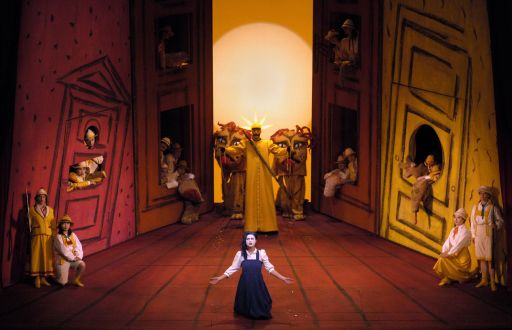Dresden. Semperoper. Opera Season 2013-2014.
“THE MAGIC FLUTE”(Die Zauberflöte)
Opera in 2 acts, words by Emanuel Schikaneder
Music by Wolfgang Amadeus Mozart
Sarastro MICHAEL ELDER
Tamino ANDREJ DUNAEV
Orator ZACHARY NELSON
1st Priest ALEXANDER HAJEK
2nd Priest CHRISTOPHER KAPLAN
Queen of the Night CHRISTINA POULITSI
Pamina ELIZABETH ZHAROFF
1st Lady BIRGIT FANDREY
2nd Lady ANGELA LIEBOLD
3rd Lady SOFI LORENTZEN
Papageno CHRISTOPH POHL
Papagena CHRISTIANE HOSSFELD
1st Man in Armour JÜRGEN MÜLLER
2nd Man in Armour TOMISLAV LUCIC
Monostatos TIMOTHY OLIVER
1st Genius NIKOLAI SKODA
2nd Genius SAMUEL MASCHKE
3rd Genius GEORG LESCH
Dresden Staatskapelle Orchestra of Saxony
Dresden State Opera Chorus of Saxony
Conductor Julia Jones
Chorus Master Pablo Assante
Director, set and costume designer Achim Freyer
Lighting Gerd Budschigk
Dresden. 10th April, 2014.
The current production of The Magic Flute at the Semperoper Dresden, by the director/producer Achim Freyer, whole-heartedly and unashamedly presented as a fairy-tale for children, is an illustrator’s delight. The scenery, on a reduced stage area, delimited most of the time by three oversized and irregularly drawn doorways, comes straight out of a children’s book, as do the naif and colourful costumes and props. Perhaps too light-hearted and clownesque for those who favour a more esoteric and erudite reading of the deeper, intrinsic, Enlightenment concerns incorporated in the opera, this production privileges the combined magical fairy tale and popular comedy elements over the other possible perspectives, the religious mystery, philosophical parable or masonic opera. Not that references to them are lacking, as seen by the masonic trowels held by the priests during the procession. In fact, this illustrated version, by being wholly removed from any attempt to portray the world realistically, manages to move fluidly, as is the prerogative of fairy tales, between the real and the unreal, the comic and the serious, the logical and the illogical. There is liberal use of pantomime effects, some mildly bawdy. There are three teletubbies, alias the three genii, playing (oversized)dice down-stage, even before the curtain goes up, to decide the outcome of Tamino’s fate. Stardust is showered at entrances and exits, and there is the use of trapdoor for immediate disappearances, revolving doors, and clown make-up. There are also a great variety of visual references besides the aforementioned,- Sarastro accompanied by lions straight out of the Tales of Narni, the chorus in mock colonial outfits, white pierrot/Noh make-up for Tamino e Pamina, – which help to kindle audience involvement in this magical and supernatural world. The company of singers in the performance on 10th April was well-balanced. Christoph Pohl‘s Papageno matched an engaging stage-presence and shtick with a well-honed and expressive vocality. Christiane Hossfeld was a pleasing though light-weight Papagena. As Queen of the Night Christina Poulitsi‘s first entrance recitative, ‘O zittre nicht’, and the following larghetto, seemed a little muffled. But as soon as she arrived at the allegro, ‘Du, du, du’, her voice opened out in clear, ringing tones. Her runs were fluid and effortless and the coloratura precise, in tune and full bodied. In the second act her aria ‘Der Hölle Rache’, she demonstrated the same technical ease and an added dramatic thrust. The warm, glowing tone of Michael Eder‘s voice, and his technical assurance and fluid delivery throughout the entire and extensive range of Sarastro’s music, gave the part a heartfelt and convincingly authoritative presence. Andrej Dunaev performed the role of Tamino with freshness and sincerity. His clear resonant tenor and sustained legato line reflected effectively the strength and courage of his character. Elizabeth Zharoff as Pamina, tended to sing at full throttle, missing the opportunities for nuance and shading. In particular, in the exquisitely moving aria, ‘Ach ich fühl’s’, with its sobbing rhythmic figure in the bZachaeautifully written orchestral part, the vocal line was sung strongly and in a direct manner, without any sign of obeisance for the aria’s inherent expression and pathos. The three genii, Nicolai Skoda, Samuel Maschke and Georg Lesch, members of the renowned Dresden Kreuzchor sang with firm, clear voices and beautifully balanced ensemble singing. They were also convincing and endearing mimes. Timothy Oliver as Monostatas gave an energetic and persuasive performance. The orator, Zachary Nelson, the two men in armour, Jürgen Müller and Tomislav Lucic, and the priests, Alexander Hajek and Christopher Kaplan, both from the Semperoper’s Young Artists’ s Programme, gave valid and appropriate contributions. The three Ladies, Birgit Fandrey, Angela Liebhold and Sofi Lorentzen moved vigorously on stage but vocally, the difference in their vibratos and the inconsistencies in articulation detracted from their ensemble singing. The orchestra played with its usual precision and beautiful tonal colour, with noteworthy solos from the basset horns. However, under the rather straightforward conducting of Julia Jones the orchestra resulted loud and heavy in relation to the stage. The chorus too, probably due to the fact that it was mostly placed off stage, came across as loud and forceful. Photo Matthias Creutziger
